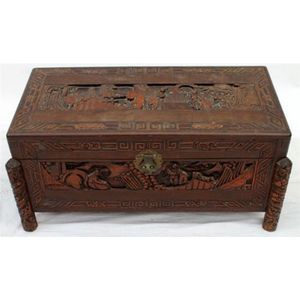Elizabethan-style Oak Coffer with Cupboard Doors
You must be a subscriber, and be logged in to view price and dealer details.
Subscribe Now to view actual auction price for this item
When you subscribe, you have the option of setting the currency in which to display prices to $Au, $US, $NZ or Stg.
- Circa - A Latin term meaning 'about', often used in the antique trade to give an approximate date for the piece, usually considered to be five years on either side of the circa year. Thus, circa 1900 means the piece was made about 1900, probably between 1895 and 1905. The expression is sometimes abbreviated to c.1900.
- Oak - Native to Europe and England, oak has been used for joinery, furniture and building since the beginning of the medieval civilisation. It is a pale yellow in colour when freshly cut and darkens with age to a mid brown colour.
Oak as a furniture timber was superceded by walnut in the 17th century, and in the 18th century by mahogany,
Semi-fossilised bog oak is black in colour, and is found in peat bogs where the trees have fallen and been preserved from decay by the bog. It is used for jewellery and small carved trinkets.
Pollard oak is taken from an oak that has been regularly pollarded, that is the upper branches have been removed at the top of the trunk, result that new branches would appear, and over time the top would become ball-like. . When harvested and sawn, the timber displays a continuous surface of knotty circles. The timber was scarce and expensive and was used in more expensive pieces of furniture in the Regency and Victorian periods. - Elizabethan - Strictly speaking, furniture usually in oak, made in the reign of Elizabetht I, from 1558 to 1603. The style incororates elaborate and ostentatious carving of classicial figures and themes and bulbous baluster legs, with an Italian Renaissance influence. When a piece is described as "Elizabethan style", it mimics the attributes of the Elizabethan period, but was made at a later date.
- Back Boards - As the name implies, the boards that back a piece of cabinet furniture such as a chest of drawers. The backing timber is usually of cheaper material like pine (often called 'deal' by the British trade), though in early Australian colonial days, red cedar was also used to back a piece. As cedar became scarcer during the later 19th century, craftsmen turned to kauri pine.
On early furniture, made before the first half of the 19th century, the backboards were often chamfered at the edges and the wide boards slotted into grooves in a supporting central frame. In later furniture, the backboards were generally nailed or screwed into rebates cut directly into the carcase and the boards became much thinner and narrower.
From about the first world war plywood was frequently used for cheaper pieces.
Backboards are one important way of judging the age of a piece of furniture.
This item has been included into following indexes:
Visually similar items

An antique French heavily carved walnut coffer. Depicting unusual mythological scenes. Bearing a heraldic shield to lid, 65.5 cm high, 105 cm wide, 58 cm deep

18th century French carved oak coffer. 157 cm long, 84 cm high, 58 cm deep

A Chinese camphor wood chest, carved with round legs on sides, with a Cloud shaped metal clasp cm, length 73 cm, depth 35, height 35 cm

Antique English oak coffer well carved panel front, approx 59 cm high, 115 cm wide, 47 cm deep
